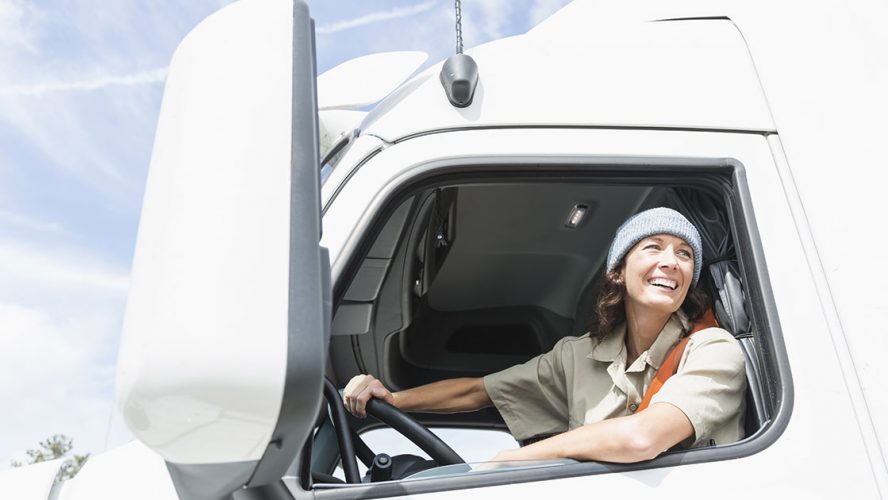Empowering female drivers is crucial for the success of the trucking industry, but there are many obstacles that must be addressed in order to get more women in the workforce.

Jamie Allison
Director of Brand Management, Phillips 66 Lubricants
A study from the U.S. Bureau of Labor Statistics reported that while there are over three million truck drivers, women only make up for six percent of the driver population. Why do you think women haven’t always sought out careers in the trucking industry?
For both the women seeking opportunities in a typically male-dominated field and for the leaders in hiring positions in those fields, we need to broaden our own assumptions about who is the right fit for the job. More women need to be encouraged to add truck driver to their consideration set when it comes to choosing a career. As industry leaders, we need to continue to broaden our perspective, challenge our own thinking and bring awareness to the topic of women in non-traditional career fields.
An American Trucking Association study reported that more than 70 percent of goods delivered in the U.S. are transported by trucks. What can the transportation industry do to continue empowering the female drivers that put in the hard work to keep America moving?
Managing a diverse workforce is a core leadership skill. Managers can empower the minority workers in their workforce by acknowledging the unique experiences and perspectives each worker brings to the team. Having a workforce that all looks the same leads to tunnel vision, and the risk of tunnel vision is missed growth opportunities for your company — including better and different ways of operating for increased profitability.
How to you think technology plays a role in providing the tools and resources to improve truck driver safety, compliance and minimize crash probability?
Technological advancements continually make vehicles safer, more reliable and easier to drive. Electronic monitoring and apps aid with safety while on the road, and that gives all drivers greater peace of mind.

Sandeep Kar
Chief Strategy Officer, Fleet Complete
A study from the U.S. Bureau of Labor Statistics reported that while there are over three million truck drivers, women only make up for six percent of the driver population. Why do you think women haven’t always sought out careers in the trucking industry?
There are quite a few reasons for this disparity, and one of the obvious ones concerns the outdated socio-economic and gender stigmas of the past, where women were expected to fulfill particular roles and steer clear of what was considered male-dominated work. Another one involves the stereotype of a physical nature, where women were distrusted to operate heavy machinery. Another reason revolves around the interior truck design that is very male-oriented. Everything from controls to gas pedal reach were always tailored to the male physique and proportions exclusively. Also, historically, trucking was not considered a safe working environment for women.
An American Trucking Association study reported that more than 70 percent of goods delivered in the U.S. are transported by trucks. What can the transportation industry do to continue empowering the female drivers that put in the hard work to keep America moving?
With the current driver shortage and high economic dependency on the mobility of goods, the industry market is coming to women. It is vitally important to make trucks more ergonomically oriented towards women. Many manufacturers, such as PACCAR and Daimler, have already begun transforming their truck design to become more female-friendly, as well as more comfortable in general. Also, historically, trucks in North America have always had manual transmissions but, today, we have semi-autonomous trucks with automated transmissions, which are much more user-friendly. Other incentives include platforms like BigRoad Freight that automate load matching for long-haul drivers, opening up broader opportunities to earn more money.
How to you think technology plays a role in providing the tools and resources to improve truck driver safety, compliance and minimize crash probability?
Technologies like Fleet Complete that leverage telematics are key to safety and compliance in the trucking industry. They automate some cumbersome, routine procedures like the mandatory hours-of-service logs that are traditionally documented on paper and are highly error-prone. They provide in-cab coaching and real-time driver assistance tools that help improve on-road performance and safer driving. There are distress buttons and other safety features that provide extra security layer and help deter any unauthorized access into the vehicle. Technology is helping the trucking industry to take bigger, speedier strides towards a more balanced work/life approach and to ensure drivers arrive home safely.
As the industry is facing a massive truck driver shortage that ultimately impacts the U.S. economy, how can recruiting and training impact driver retention?
Women can help fill the gap in the driver shortage crisis. Recruitment should focus on all of the innovative advancements that are currently taking place in the field, like the more women-friendly truck designs, to appeal to the idea that the industry is changing and modernizing at accelerated rates, and the new vision of trucking is gender-equal. Technology also allows staying more connected with family and friends while on the road, so truckers are not so solitary nowadays. Moreover, with technologies available to stimulate safer driving habits and help prevent crashes and incidents with in-cab feedback, the overall trucking environment becomes more reassuring and profitable. These things should be at the forefront of recruitment.
How can promoting STEM programs encourage females to pursue and ascend the industry ladder in a way that will change undoubtedly impact the trucking industry?
Technology is the fuel behind the positive changes and progress in the trucking industry today, and it is a highly prospective field to engage in. STEM programs should be encouraged among women from the very beginning of the education circuit to move the needle in the right direction with female industry champions who have made it. The shortage of female professionals in the sector should be a thing of the past, and more vocations in the automotive sector should be made attractive to women that might not have been traditionally before.
What can industry leaders do to advocate for the employment of more females and actively address and remove the obstacles that may keep them from entering the field?
Industry leaders should create greater awareness that good economy hinges on shifting the gender ratio in trucking and that it is very important to fix the crippling problems in the industry that discourage women – a large part of the workforce – to partake in the trucking profession. It needs to change, and it needs to change fast because, as the driver numbers dwindle, so does the economic potential. We need more female proponents of the trade to generate a ripple effect that will resonate with industry stakeholders throughout. We need more original manufacturers to step up their game in advancing the truck design to accommodate the needs of women as well as men. The industry depends on it.

Megan Pino
Shell Rotella Global Brand Manager, Shell Lubricants
A study from the U.S. Bureau of Labor Statistics reported that while there are over three million truck drivers, women only make up for six percent of the driver population. Why do you think women haven’t always sought out careers in the trucking industry?
I believe women are more likely to have families and therefore being on the road and away from their loved ones would prove very difficult. In addition, trucking can be a dangerous job, which can deter women from going into this line of work.
An American Trucking Association study reported that more than 70 percent of goods delivered in the U.S. are transported by trucks. What can the transportation industry do to continue empowering the female drivers that put in the hard work to keep America moving?
I think one way to continue to empower female drivers is to continue to make improvements in safety and work-life balance. Women need to feel confident they are safe and protected in their jobs. Any improvements in work-life balance, allowing women to be home more often, will attract women to the industry.
How to you think technology plays a role in providing the tools and resources to improve truck driver safety, compliance and minimize crash probability?
Technology is a key enabler to advancing the industry in many capacities. Safety, as I’ve mentioned previously, is a strong component to women entering the industry. As more and more technology advancements are developed and implemented in the marketplace that improve safety, I think we will see more likelihood for women to become truck drivers.
As the industry is facing a massive truck driver shortage that ultimately impacts the U.S. economy, how can recruiting and training impact driver retention?
Recruiting can impact retention by being upfront and honest regarding life as a truck driver. If new recruits are sold on fallacies, retention quickly becomes even more of an issue. On-boarding and training a new driver is very expensive, so ensuring the right employees are hired in the first place can minimize this cost. Training can also impact retention in that drivers that feel confident and comfortable on the job, due to effective training, are more likely to stick around. They are also more likely to feel valued and important by their employer and safer on the road.
How can promoting STEM programs encourage females to pursue and ascend the industry ladder in a way that will change undoubtedly impact the trucking industry?
I feel very strongly that STEM programs are a wonderful way to get young girls involved in industries and jobs that they may not have naturally chosen but provide rewarding careers.
What can industry leaders do to advocate for the employment of more females and actively address and remove the obstacles that may keep them from entering the field?
Focusing on recruiting females into the industry must continue as many women likely do not consider trucking as a viable career option. In addition, the more the industry can make trucking a career with flexibility for women that have responsibilities at home that require them to be home more often, as well as increasing safety, the more attractive it becomes to women. And even just bringing this career option to the attention of women through affective recruiting can positively impact the number of women that chose trucking as their career.

